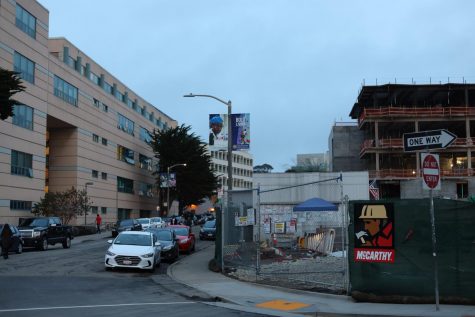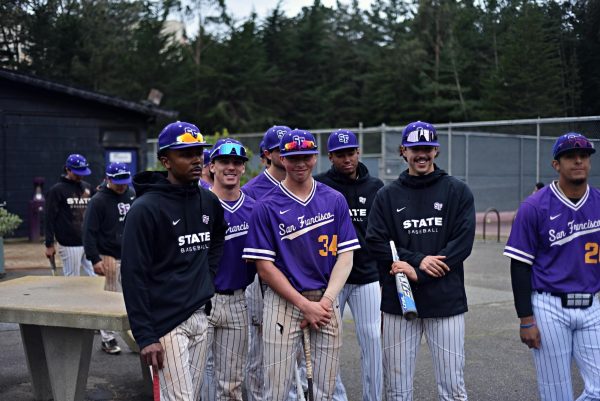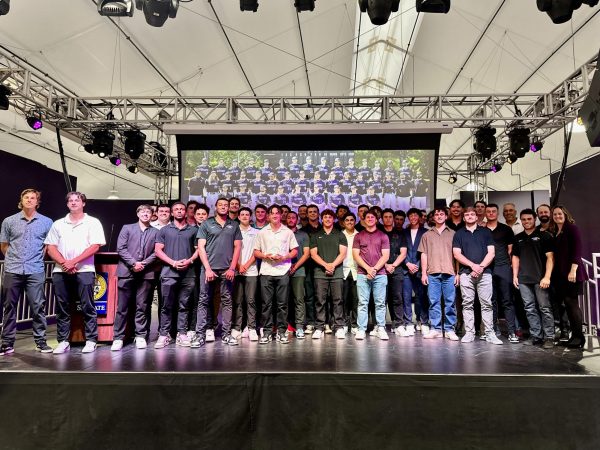Give Multimedia Students Access to Resources
January 28, 2020

As a massive new Liberal and Creative Arts building to house the Broadcast and Electronic Communication Arts (BECA) department is taking shape at SF State, just across the street, the Journalism (JOUR) department is rapidly falling under its shadow.
The new building between Holloway Avenue, Font Boulevard and Tapia Drive will be finished in December 2020 and will be open for classes starting spring semester 2021, according to Jason Porth, executive director of University Corporation, SF State (UCorp).
Porth wrote in an email that the building will be outfitted with state of the art facilities which will benefit the entire campus community and support the university’s mission.
It will contain a station for the campus KSFS radio, two TV studios, a news studio, a huge media presentation room, and multiple audio and editing booths as well as classrooms, offices and open work spaces, according to building plans available for public viewing through SF State’s website.
This will ensure BECA students have the opportunity to explore their passions, and the equipment, space and resources to facilitate that.
But unfortunately, at this time, the JOUR department right across the street has no upcoming classes or partnerships within that new building.
JOUR professor and department chair Rachele Kanigel said she is in preliminary talks with the department head of BECA about possibly cross-listing courses in the future. She said in the past the Golden Gate Xpress has collaborated with the BECA news broadcast “State of Events.”
“I think it’s great if the leadership of the Xpress publications and the leadership of KSFS and State of Events are in touch with each other about collaboration,” said Kanigel. “As far as the building goes, there are no plans for us to have any classes or offices.”
Each class we take in JOUR hammers into our minds that multimedia skills are what the world of journalism needs. These skills make us marketable within a deeply competitive field, and they encourage us to explore new solutions-based journalism efforts that represent communities fairly and connect to broader audiences.
“I’m hoping that as multimedia changes—I mean right now multimedia means video and text and still photos, but it may mean AR (augmented reality) or AI (artificial intelligence)—there’s lots of things I would love to see us doing in the future,” said Kanigel.
There is no point in teaching us the value of multimedia work if we have no access to proper spaces to produce, equipment to use and resources to finish the job.
Right across the street, future BECA students will have the opportunities JOUR students do not.
There are projects that both departments would like to create: consistent podcasts, documentary video segments, and more, which would be much more easily accomplished if the work was shared between the departments.
Imagine you want to create a podcast. It may seem pretty simple, as the common joke says “everyone has a podcast these days.” But in order to create a well-produced show that posts regularly, you have a laundry list of needs:
A soundproof space to record, microphones, headphones, a website, social media accounts, editing software, writers to create content, hosts that connect with your community, audio engineers who ensure you’re recording correctly, editors that put together each episode, and producers who do nearly everything else, like posting each episode online, maintaining social media and obtaining sponsorships so you can keep working.
This can all be accomplished by one person, but it is a feat. If you want to publish regularly, you need resources and a team you can trust. Think of collaboration as the elixir of good podcasts.
As the field of journalism changes drastically day by day, what both our departments need is each other. We need more articulation between these two departments, specifically regarding multimedia journalism.
We need more support from our administration for both departments. And we as students need to recognize the power we hold as the main source of revenue for this university and take charge of our education by collaborating with other students.
Golden Gate Xpress attempted to reach out to the BECA department office but they refused to comment.















Ron • Jan 29, 2020 at 5:59 pm
BECA has always wanted to collaborate with journalists. It’s too bad their administration doesn’t want to…